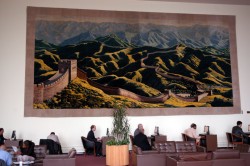New Zealand was one of approximately 32 governments to speak on the second day of the small arms Review Conference here in New York. Nik Kiddle, our deputy disarmament representative from Geneva, gave the speech, which included support for the Arms Trade Treaty and the need to place the small arms problem within the broader context of development. New Zealand was among at least a dozen speakers that talked about the need to address transfer controls on governments. These are two principal items that Oxfam is been seeking government support for.
 During the lunch hour I tried, but couldn’t even get it in the door for a crowded event to release IANSA’s “Red Book†report on implementation of the Small Arms Programme of Action. A lot of great research has been prepared for release this week, including Oxfam’s report on the AK47 assault rifle that it highlighted with a huge statue unveiled yesterday of a huge AK47 made from prosthetic limbs. Another report, the 2006 Small Arms Survey includes some great statistics and an overview of gun violence in Papua New Guinea.
During the lunch hour I tried, but couldn’t even get it in the door for a crowded event to release IANSA’s “Red Book†report on implementation of the Small Arms Programme of Action. A lot of great research has been prepared for release this week, including Oxfam’s report on the AK47 assault rifle that it highlighted with a huge statue unveiled yesterday of a huge AK47 made from prosthetic limbs. Another report, the 2006 Small Arms Survey includes some great statistics and an overview of gun violence in Papua New Guinea.
Throughout the day I saw U.S. ambassador John Bolton in the corridors as our meeting room is just down the hall from the UN Security Council then in the evening I met the man himself when he invited governments to a reception at the U.S. Embassy. I went as a member of the NZ delegation and consequently found I was the only NGO in the room. That’s if you don’t count the National Rifle Association and other gun lobbyists such as the one on the N.Z. delegation.
 It was a typical U.S. reception in which their diplomats approached us to find our views on the U.S. position that was given in a speech during the day. While making clear I was an NGO rep on a government delegation, I spent some time talking to the U.S. delegation including fifteen minutes with Bolton’s chief of staff discussing, among other issues, why the U.S. continues to resist efforts to include the impact of armed conflict and small arms on development (Bolton’s aide: “disarmament matters should be discussed separately from development”). I asked why the persist when they lost a UN General Assembly vote on the matter last year by a vote of 190 governments to 1 (“we get lonely sometimesâ€). I tried to get more details on what the U.S. meant in its speech when it stated its opposition to negotiations on transfer controls i.e. Arms Trade Treaty, but professed support for discussion of global principals governing arms trade.
It was a typical U.S. reception in which their diplomats approached us to find our views on the U.S. position that was given in a speech during the day. While making clear I was an NGO rep on a government delegation, I spent some time talking to the U.S. delegation including fifteen minutes with Bolton’s chief of staff discussing, among other issues, why the U.S. continues to resist efforts to include the impact of armed conflict and small arms on development (Bolton’s aide: “disarmament matters should be discussed separately from development”). I asked why the persist when they lost a UN General Assembly vote on the matter last year by a vote of 190 governments to 1 (“we get lonely sometimesâ€). I tried to get more details on what the U.S. meant in its speech when it stated its opposition to negotiations on transfer controls i.e. Arms Trade Treaty, but professed support for discussion of global principals governing arms trade.
Eventually the aide professed that he had really come to the reception for a drink after dealing with North Korea all day!
 The conference started late today as the General Assembly room was in use for an event to welcome the Republic of Montenegro as the newest (192nd) member of the United Nations. Finally Serbia is completely alone.
The conference started late today as the General Assembly room was in use for an event to welcome the Republic of Montenegro as the newest (192nd) member of the United Nations. Finally Serbia is completely alone. 





